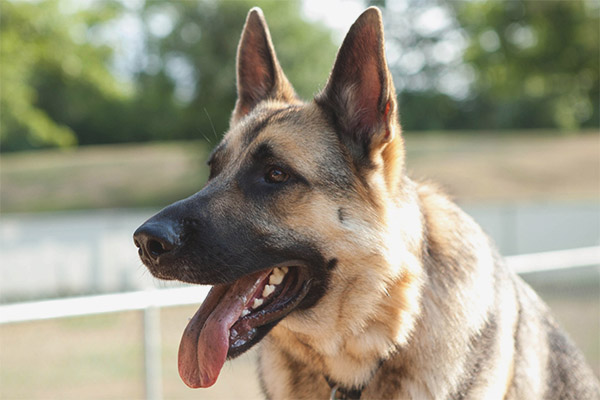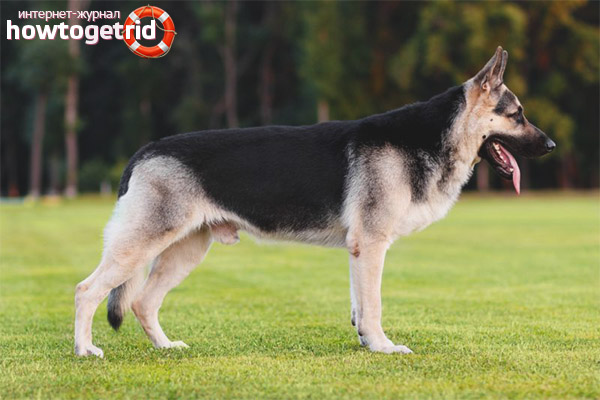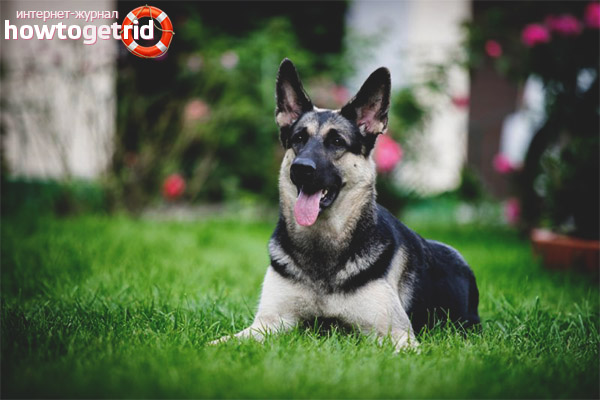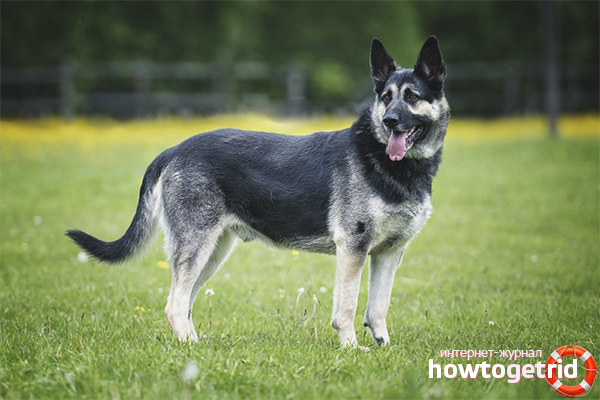The content of the article
Many dog lovers are mistaken when they say that the Eastern European is the same German Shepherd. But, to be honest, and to delve into the history of the origin of the breed, this is true.
History of origin
The Eastern European representative was a descendant of a German shepherd, but already in the territory of the countries of the Soviet Union. And here these representatives were singled out in a separate breed. There are many reasons for this event. The first of these is the human factor. Soviet dog handlers differently approached the education of dogs. In addition, climate played a significant role.
In many countries, they appreciate the quality of the German Shepherd, which allows her to be a great helper in official matters.But, unfortunately, after the times of the First World War, the people of the countries of the Soviet space had a negative attitude towards anything that had German roots. Therefore, significant changes were made even in the education of German shepherds so that they were not similar to their German relatives. Canine Soviet times made a lot of effort to make adjustments to the breed as a whole, because this state demanded a strong work force in the form of dogs. This case was taken seriously, and the breeding of shepherd dogs, as well as their upbringing, was not just for fun.
In the post-war times, namely, in the 24th year of the last century, a separate nursery called “Red Star” was created for future Easterners, in the main Soviet capital of those times - Moscow. In this institution they worked on breeding their own breed from representatives of the German breed of sheep-dogs. Due to the fact that not enough money was allocated for this process, they achieved their first results only in 1945. This happened due to the fact that after the war, captured German breed shepherd dogs remained on the territory of the Soviet countries.Later they were used for breeding.
The handlers were set a goal, which was to change the behavioral characteristics of the German Shepherd Dog, and to make the future representative of the Eastern European larger in size. And it is worth noting that this goal was achieved.
Outer features also succumbed to some changes. The same applied to the nature of the animal, as well as its behavioral characteristics. In addition, representatives of the EEO were to become more universal animals, whose labor could be used not only in a specific territory, but throughout the entire area of the Soviet Union.
At the end of the hostilities of 1941-1945, the former representatives of the German Shepherd Dog, who had undergone "retraining", were recognized as General Medvedev, and were called Eastern European breed. And also, for her achievements during the war, these dogs were considered the most patriotic animals.
But it was only in 1964 that they described the standards that a VEO should have, and 12 years later these standards were subject to corrections. It is worth noting that, nevertheless, this supposedly innovative breed was considered a subspecies of the German shepherd, so they were not divided into 2 different breeds.But soon a turning point came for the Soviet Union, as well as for the breed.
When a great country fell apart, all of its achievements in general, as well as in the selection of Eastern European breed, succumbed to criticism. This fate also overtook these dogs, which for some reason were associated with Stalin and the times of repression. But the fact is that during their service in the countries of the Union, these dogs performed quite a lot of roles that were associated with mine detection, saving people, searching for explosives, protecting people and their possessions.
So, despite all the difficulties, these times for the VEO made a positive impact in their direct development. Those who were engaged in breeding this breed only because of self-interest, left this business, and only those who really appreciated and loved these animals remained with dogs.
The consequence of the refusal of recognition of this type was the creation of the Association of Kennels in the 91st year, and already in the 99th a book was published dedicated to the pedigrees of East European dogs. The development of the breed continued, and it concerned not only external signs, but also the nature, qualities that would help in the service.
Those who were engaged in breeding and training of representatives of the East, not only saved the number of animals, but also multiplied them. And soon, Russian dog associations began to gradually recognize the breed. So, already in 2002, their former glory and honor returned to these dogs.
Breed standards
BEO is considered to be a fairly large dog, with an average male height of 66-76 cm, and 62-72 cm - in females.Despite the strong bones of the shepherd, the body of the animal does not seem rude. There is a certain elongation of the body, which can differ by 10-17 cm from the average height of the dog. Eastern European representatives are quite muscular. Males are much larger than females, therefore, it is very easy to determine the sex of a dog.
The head is elongated, wedge-shaped, and, despite its massiveness, looks proportional to the body. The transition to the face from the frontal part is not expressive. Ears are in a standing position, similar to triangles. Eyes expressive, but small, almond shaped. The dog’s look is special, one can immediately see from it that it is smart and quick-witted. The jaw of an animal is well developed and has 42 teeth. The neck looks tough and as muscular as the body.
The belly is always tucked up, and the back is even. In calm and static position the tail is always omitted. Limbs shepherd pretty strong. The front are placed at a small angle, which simplifies the movement, and the rear are straight.
The hair of the dog is of medium length, and on the forearms and hips a little longer. To the touch it is tough, and fits snugly to the body. The undercoat is rather thick.
With regards to color: it must be black, black with a dark mask on the face, on a lighter background. It is also possible deep color of the black type, red and gray areas are allowed, but not desirable.
Difference of a German shepherd from East European
Eastern representatives, even without taking into account the fact that they are not separated by an international federation of dog handlers from German shepherd dogs, have significant differences. Its main features inherent only to it are expressed as follows:
- The VEOs look larger than their German counterparts, and also slightly taller.
- They have a smoother back, and German shepherds have a sloping one.
- German representatives have a narrower chest.
- East Shepherd moving more sweepingly.
- German dogs have less light background in color.
- East-European shepherd dogs have a calmer temperament, and German shepherds are much more playful, more active.
- German breed sheepdogs are more suitable as companions for humans, and Oriental men are used to carry out official work.
Character Veho
The most pronounced trait of character is attachment to its master.This dog is quite brave, and can execute any order of a person, to the extent that he can give his life for him. The nervous system of the animal is very stable, so the shepherd does not show its aggression without the need, but treats strangers with distrust. But, if any danger arises, she responds instantly.
These representatives are ideal animals for training. They show their obedience, and not at all trying to dominate or show will. Sheep-dogs will not cause harm to animals, smaller than themselves. And if the eastern shepherd grew up in a circle of other animals, then in the future they will be protected.
These dogs are very friendly in nature. But this is manifested only in relation to family members. And, if even the slightest danger threatens the owner, the dog immediately turns from a friendly dog into a fighting dog.
Sheepdog is considered a loyal friend and loyal protector. In relation to children, they are always friendly and love to play with them. If you are engaged in the education of the East European shepherd, then her character will correspond to that described.
Training and education
In order for a dog to have all the traits that may be inherent in it, it is necessary to engage in its education from the very young age. The first thing to do with a little puppy is to find contact with him. At this time, you can devote only 15 minutes to develop the skills of the animal.
To baby listened to, it is worth using food. After a correctly executed command, you need to give some kind of treat to develop a reflex in the dog.
Already from the age of three months you can begin to teach the puppy to obey the owner. During the walks, to teach him that among the heaps of sounds he needs to hear the commands of his master.
At 4 months, it is worthwhile to introduce the training of the ability to overcome barriers, look for hidden things by smell. If development of official qualities is necessary, then the age of 5 months is ideal for this. This includes the protection of things, as well as the attack for the attacker. But all these activities should be carried out with the help of a stranger. Since this quality is laid by the Easterners, there should be no difficulties with this task.
In addition to performing basic commands, the dog must not take food from the hands of strangers, pick up food.
Care and maintenance of the Eastman
This type of care does not require special care. And most importantly, it needs to be organized - this is the right feeding and active walks. It is also important to carry out hygiene procedures. Shepherd can live in the apartment, as well as in the booth. But the main thing is that it is spacious, because these animals are rather large. It should be noted that you can not first keep the animal in the apartment, and then move it to the aviary with a booth.
It is necessary to wash the eastman, but not more often than twice a year. And that, this must be necessary. The main thing that needs to be done is to comb the animal, and then the fur will not be dirty, and its appearance will be more well-groomed. In addition to combing out lost hair, a massage is performed by combing, which helps to improve blood circulation.
Also do not forget about the ears, eyes and teeth. If the health of the pet is all right, then cleaning the ears once a fortnight with a cotton swab is enough. Brushing your teeth is also necessary to avoid tartar. It is not necessary to clear the eyes if there is no selection on them. If they are still there, they should be removed with a cotton swab. This should be approached with all seriousness, if the East European Shepherd takes part in exhibitions.
Do not forget about the treatment of worms and fleas.It is recommended to clean up the fleas in May or June, when the parasites are actively developing, as well as in October, when they become less active.
Feeding
Food is the main component of the correct development of the animal. First of all, it must be balanced. The main component of nutrition is protein-containing products, that is, meat and meat products. You can include in the diet porridge with vegetables, as well as river fish, which will be useful for puppies. But it must be boiled so that the dog does not become infected with worms. It is allowed to give dairy products (remember that milk is contraindicated for adults, it is useful only for puppies, up to 6 months of age).
Making a dog diet is not an easy task, so many people choose a simpler way and buy dry food.
How to choose a puppy
If you want to buy an Oriental keeper, then it is best to give preference to kennels, where you can choose a puppy of this particular breed. The advantage of kennels is that there you can learn about the pedigree of the animal and any other data regarding the dog. What can not be said about buying a puppy on the market or on an ad on the Internet. It is not only impossible to find reliable data here, but you can even buy a purebred puppy at the cost of an oriental.
In order not to be mistaken when choosing, you can visit the monobreed dog show, or even watch the video with them, visit the forum. This will provide an opportunity to see firsthand the representatives of the East European Shepherd Dog, talk with the owners and learn about their features. If you take this issue seriously, then you can buy a real Oriental.
Cost of Eastern puppies
Purebred puppies of the Eastern European species, along with the documents will cost its future owner in the amount of not less than 15 thousand rubles. The price may rise, because it depends on whether there were eminent ancestors in the family. You can also buy a puppy for 3 thousand, but this will mean that the puppy has no pedigree.For such a price, you can buy a good pedigree dog, but there is also a risk that the breeders want to sell a shepherd puppy at this price, but not the eastern one, but the German or even ordinary half-breed. If the choice is quite fundamental, then it is better to overpay a significant amount, but be sure that the puppy bought is exactly the breed you need. And then you will not have to be disappointed in your choice and feel sorry for the money spent on the wrong pet that we would like.
Video: East European Shepherd














To send